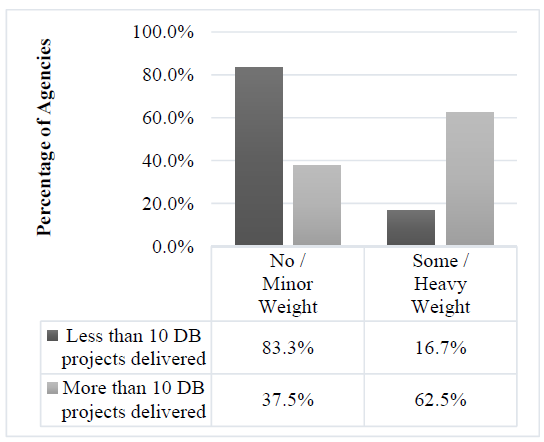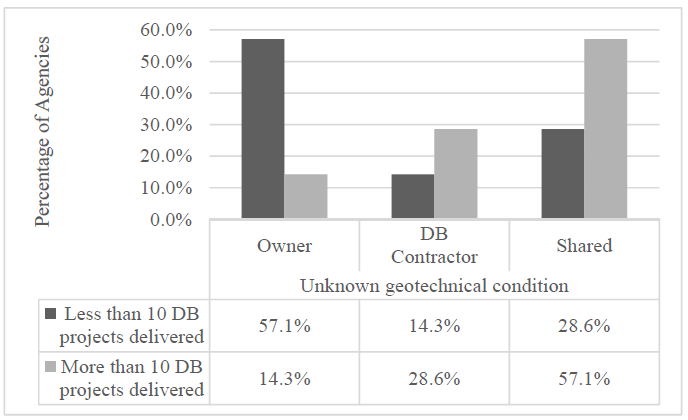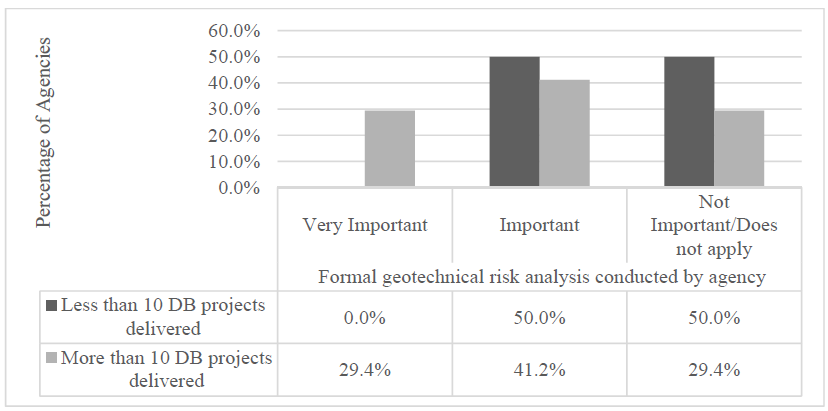ABSTRACT
State highways agencies policies and procedures for articulating geotechnical information and requirements on Design-Build (DB) projects is a means to manage geotechnical risks. Successful approaches and practices to managing geotechnical risk not only reduce the level of geotechnical uncertainty for both the owner and the competing design-builder, but also distribute the remaining geotechnical risk between the parties.
This paper discusses the differences in regard to geotechnical risk management, aspects of the DB procurement process, and contract aspects between state departments of transportation (DOT) with experience delivering projects using DB versus those who are not as experienced. Results are presented from two independent sources of information; one was obtained through literature review of aspects related to geotechnical requirements and management of DB projects, and the other was through an online-survey of 38 DOTs. Results of the study statistically demonstrate the value of DB experience in managing geotechnical risks, and accordingly presents a set of recommended practices for agencies that are relatively new to DB project delivery, during both procurement and contract formation.
RESEARCH METHOD
The study’s methodology relied on two independent research instruments. The first instrument was a comprehensive review of literature on managing geotechnical risks in DB projects. The literature review focused on current DOTs processes used regarding geotechnical requirements of DB projects and it included review of DOT risk management manuals.
The second instrument was an online-survey whose purpose was to identify DOT policies and procedures for articulating geotechnical information and requirements on DB projects. The survey was initially issued to the members of the AASHTO Subcommittees on Construction and Design in each of the 50 DOTs.
ANALYSIS AND RESULTS

As detailed in the methodology, the analysis of the survey sought to investigate the differences between experienced and non-experienced DOTs in regard to geotechnical factors. Results of the survey was analyzed using both descriptive and inferential statistics, and was divided into responses from experienced versus non-experienced DOTs as shown in Table 1. The inferential statistics implicated hypotheses testing with the Pearson chi-square to determine whether there is statistically significant difference in the perception of DB projects’ geotechnical factors/areas adopted by agencies.

Figure 1: Geotechnical Evaluation Criteria Weighting.
In terms of weight of geotechnical factors, Figure 1 shows a comparison of experienced versus non-experienced DOTs in terms of their perception of geotechnical factors weight with regard to all other evaluated factors if they are included in the DB project’s evaluation plan.
It is seen that while more than 80% of non-experienced DOTs agree that geotechnical factors have No/Minor weight in their evaluation plans, more than 60% of experienced place a Some/Heavy weight to geotechnical factors. This shows how experienced DOTs, in general, are more aware and realize the importance of the geotechnical factors in the evaluation plan on DB projects.
As for the three geotechnical factors shown in Figure 2 in terms of their impact on the final quality/performance of the DB project, a consistent difference is observed in the higher consideration of experienced DOTs of these factors compared the non-experienced DOTs. For instance, 100% of experienced DOTs not only agree in rating the qualification of the design builder’s geotechnical staff as a very/high impact, but also agree in rating the design-builder’s past project experience with geotechnical issues as very/high impact. In contrast, non experienced DOTs results are dispersed across the range of impacts.

Figure 3. Geotechnical Risk Allocation.
Another interesting difference between experienced and non-experienced DOTs is related to the allocation of geological uncertainty. Figure 3 illustrates that while 57% of experienced DOTs are more willing to share the subsurface risk uncertainty rather than bear it, more than 50% of non-experienced DOTs are willing to bear the risk rather than share it, and only 14% of these DOTs allocate it to the owner.

Figure 4: Formal Geotechnical Risk Analysis.
Finally, Figure 4 shows the other prominent difference between experienced and nonexperienced agencies which was the perception of the level of importance of completing a formal geotechnical risk. Over 70% of experienced DOTs rated a formal geotechnical risk analysis as either “important” or “very important,” while 50% of non-experienced DOTs gave the formal analysis of geotechnical risk no importance.
CONCLUSIONS AND RECOMMENDATIONS
This paper’s main objective was to investigate the differences between DOTs experienced and non-experienced in delivering DB projects’ in regard to geotechnical risk management, aspects of design-build procurement process, and aspect of design-build contracts. Experience was measured by the number of DB projects delivered.
Through an online survey administered to State transportation agencies, it was evident that DOTs with more experience in delivering DB projects viewed and handled geotechnical risks differently. The significant difference was observed in the importance of the qualifications and past experience of the design-builder’s geotechnical staff. Another relevant difference was in the degree of impact of the designbuilder’s past experience with project-specific geotechnical issues.
Furthermore, the paper finds that experienced DOTs allocated unknown geological condition risk differently than nonexperienced DOTs. Experienced DOTs tend to share unknown geotechnical conditions risk while non-experienced DOTs either allocate all the risk to the owner or attempt to shed it. Also, experienced DOTs do understand the importance of providing as much geotechnical investigation information as possible during the procurement process to reduce uncertainty as much as possible during bidding. Non-experienced DOTs opinions are spread across the spectrum of possible options.
Source: Iowa State University
Authors: Ivan Castro-Nova | Ghada M. Gad | Douglas D. Gransberg
